Device Inventory Reports
Este informe permite generar inventarios detallados de los dispositivos monitorizados en WOCU-Monitoring, ofreciendo una visión completa de sus características técnicas de forma rápida y sencilla.
Devices are automatically recorded in an inventory managed by WOCU-Monitoring, where each item is enriched with relevant technical information. From this inventory, these types of reports are generated, compiling those devices whose data matches the criteria or filters defined when generating the report.
The following details the process for creating and running reports, establishing a series of filters and parameters customized by the user.
Configuration and generation of Device Inventory Reports
Generally, when creating reports, the user should access the blue + Add button, located within the Reports section.

Before generating the report, you will need to configure a series of parameters described below:

Date range
This parameter establishes the time period for which the Availability calculation will be performed.
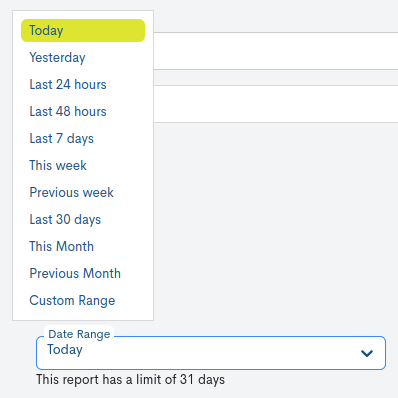
There are several time criteria already established:
Parameter |
Description |
|---|---|
Today |
Filters and displays only data recorded during the time period that elapsed today. |
Yesterday |
Filters and displays only data recorded yesterday. |
Last 24 hours |
Filters and displays only data recorded in the last 24 hours. |
Last 48 hours |
Filters and displays only data recorded in the last 48 hours. |
Last 7 Days |
Filters and displays only data recorded in the last seven days. |
Last 30 Days |
filters and displays only data recorded in the last thirty days. |
This Week |
Filters and displays only data recorded during the time period elapsed in the current week (from the week’s start date to the current day). |
Previous Week |
Filters and displays only data recorded in the previous full week(Monday to Sunday). |
Last 30 days |
Filters and displays only data recorded in the last 30 full daysfrom the current date. |
This Month |
Filters and displays only data recorded during the time period elapsed in the current month (from the 1st to the current day of the month). |
Previous Month |
Filters and displays only data recorded in the previous full month (from day 1 to day 28/30/31). |
If you want to define a specific time period, you can use the Custom Range option. To configure the time range, you must specify a start and end date. Clicking on a day will select it and highlight it with a blue background. In addition to the date, you can specify a specific time within that day using the drop-down menus for hours, minutes, and seconds, until you reach the exact moment you want. The selected date and time will be displayed in both the upper and lower boxes of the view.

Using the plus sign (+) button, you can add multiple date ranges for data collection in the configured report. If you want to delete one, simply press the red button with the cross (X). The range will disappear, and when you run the report, only the remaining periods will be taken into account.
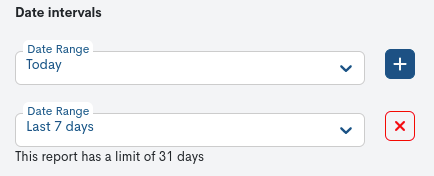
Attention
Obviously, it is not possible to choose start and end dates after the current date, nor to set an end date before the start date.
Name
Required field to record a report identifier term.
Report Template
In this optional field, the user can select the template they wish to apply to the report. Templates are pre-created and available for reuse during report configuration. More information can be found at: Templates.
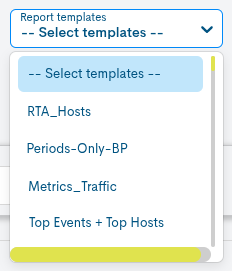
Report Covers
In this optional field, the user can choose a predefined cover for the report. This includes a cover image, a header on the pages, a main title, and a footnote. This gives documents a corporate and professional appearance, tailored to the organization’s visual identity. More information can be found at: Covers.
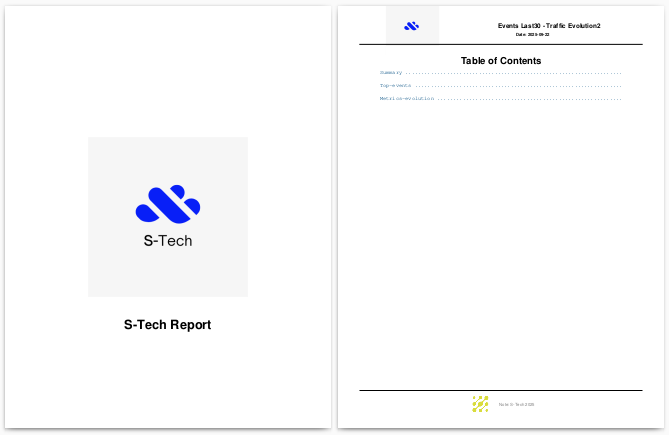
Description
Optional field where the user may include descriptive text relating to the report.
Visibility
In this field, the user will determine whether the report will be visible to other users (i.e., a public report, Public), or whether it will be private and visible only to the report’s creator (Private).
Report Type
In this drop-down field, the user must select the type of In this case, it will be Device Inventory.

Note
Depending on the type of report selected, new fields to be defined will be automatically included.
Retrieve hosts without inventory?
Selecting this checkbox will retrieve in the report the Hosts that have not been enriched with data in the inventory.

Retrieve full inventory
Selecting this checkbox will retrieve the complete inventories of the Hosts (if any), which comply with the filters applied in the report generation. Unchecking it will retrieve only those data indicated through the filters.

Sections
The sections are different pre-established inventory categories, which include hosts according to a set of technical characteristics collected in the inventories. Depending on the section chosen, WOCU will launch a report where a list of hosts assigned to that section will be retrieved.

It is possible to both broaden and refine this field from various options.
These are:
Refine by adding Keys to the section
WOCU-Monitoring allows to further narrow down the configuration of the report by assigning Keys. Keys are the inventory of a monitored host.
For this field to be displayed, click on the button with the button with a downward pointing arrow (↓ Add Key), located on the right of the section bar. To remove it, just click on the red button with the bin icon and the field will disappear.

It is also possible to narrow down a Key. By pressing the blue button with the icon with an arrow pointing to the right (→), another field called Value, which allows you to define a value for the key previously selected. To remove it, simply press the X button and the field will disappear.
Expand the report by adding another section
There is the possibility to add several sections in a single report. On the right of the Sections bar there is a button + Add Section button, clicking it will bring up a new row to select a new section. In case you want to delete one of them, just click on the button with the bin icon and the field will disappear.

Note
The corresponding Sections, Keys and Values are created and configured in WOCU-Monitoring by the Administrator.
Host Group
This configuration parameter allows filtering of the data collected and reflected in the report, showing only those datarelating to the Host Group existing in WOCU-Monitoring.

Simply choose the group name from the Device Group (Host Group) dropdown. All groups registered within the realm will be displayed.
To deactivate the filter, the user must choose the No HG filter option, which appears first in the list.
To save the configuration and generate the report, click on the blue blue Create.

Once the report has been created and scheduled, you will be taken back to the initial screen of this section, where the reports will be sequentially stacked in the Centralized Report Management.

Click on the Name to access the full report. The user is then taken to a new report window where the information generated and collected by the system is presented. These panels are described in detail in the next section.

Setting up a multiple report
WOCU-Monitoring allows the creation of multiple reports in a single operation. This allows the user to define several reports of different types from a single configuration form.
The operation is simple and intuitive. Once the user selects the first report, the system enables the + button in the upper right corner of the configuration form. Clicking this button displays a new form for defining another report.
Attention
The system supports the combination of the seven types of reports available, as long as they are of different types.
If a report is to be deleted, the user can use the x button, which deletes the previously configured settings.

Each configuration form includes a Hide Report Config button (identified by an eye icon with a diagonal line through it), which allows you to hide the corresponding configuration view and expand the available screen space.
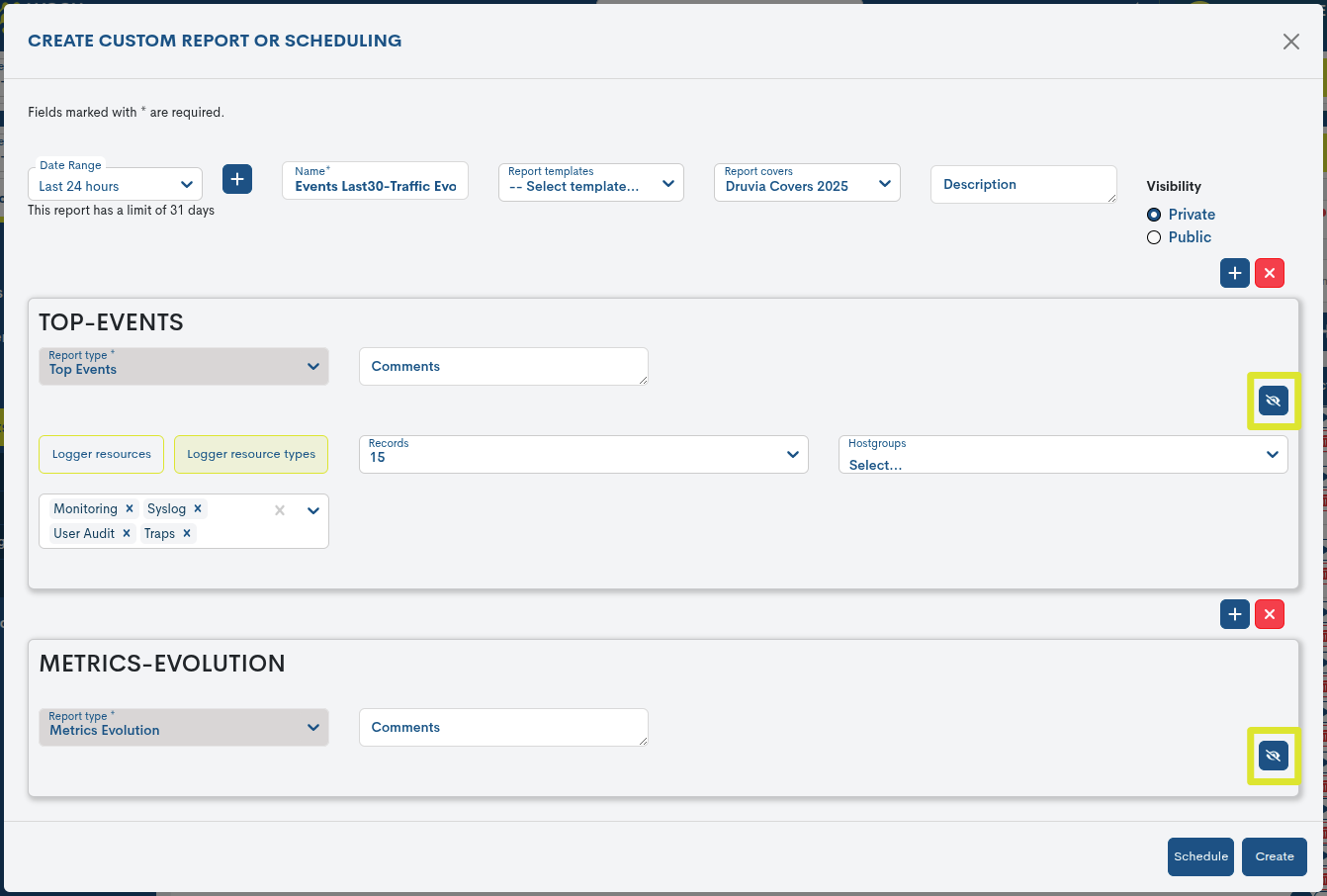
See the following multiple report structured in two separate sections:
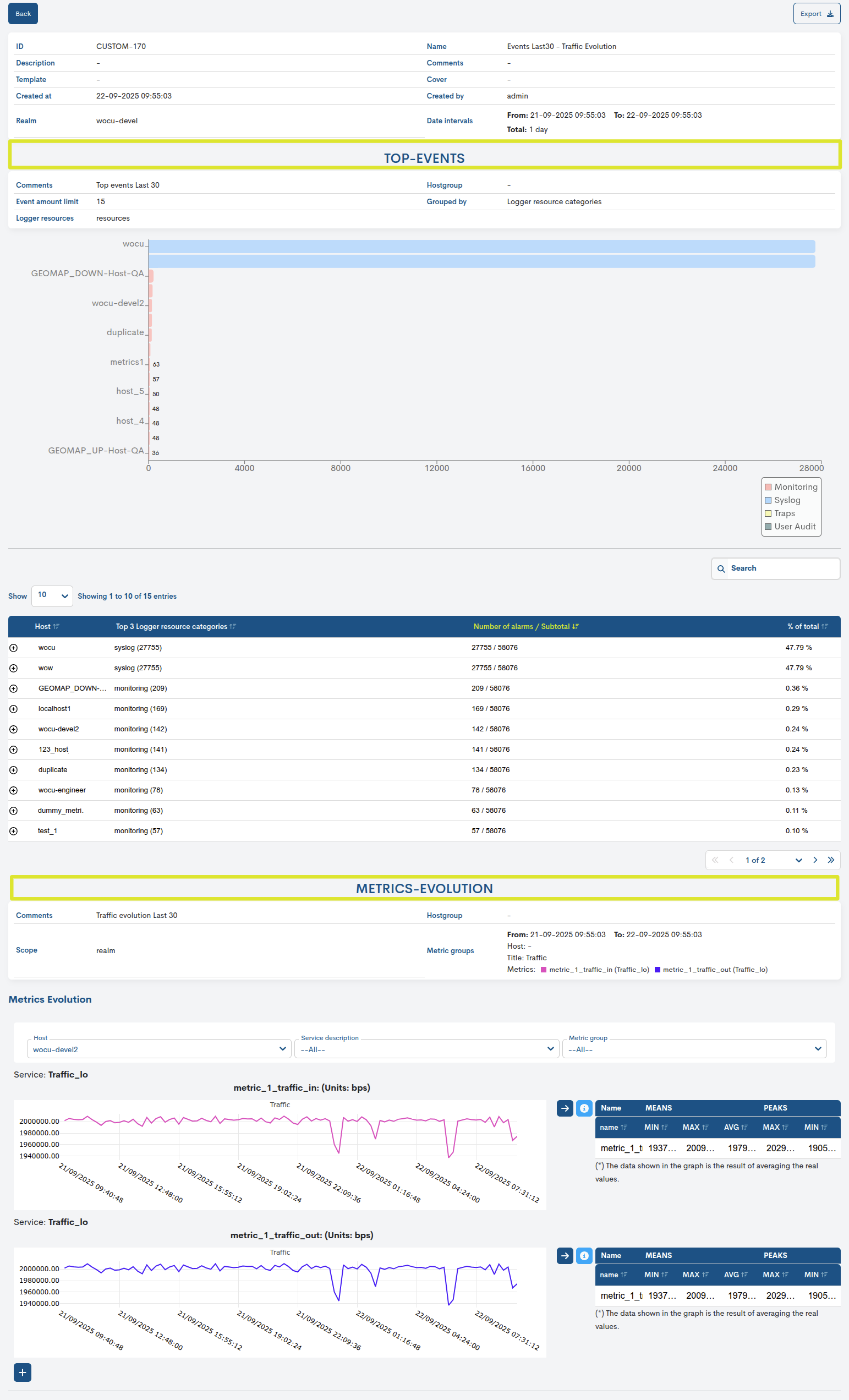
Scheduling of Device Inventory Reports
WOCU-Monitoring also allows for the automation of reporting operations, thanks to the ability to schedule their generation and launch at the user’s discretion using the Schedule button.

Next, a form will appear to begin setting up your schedule. For more information, see the following section: Schedule.
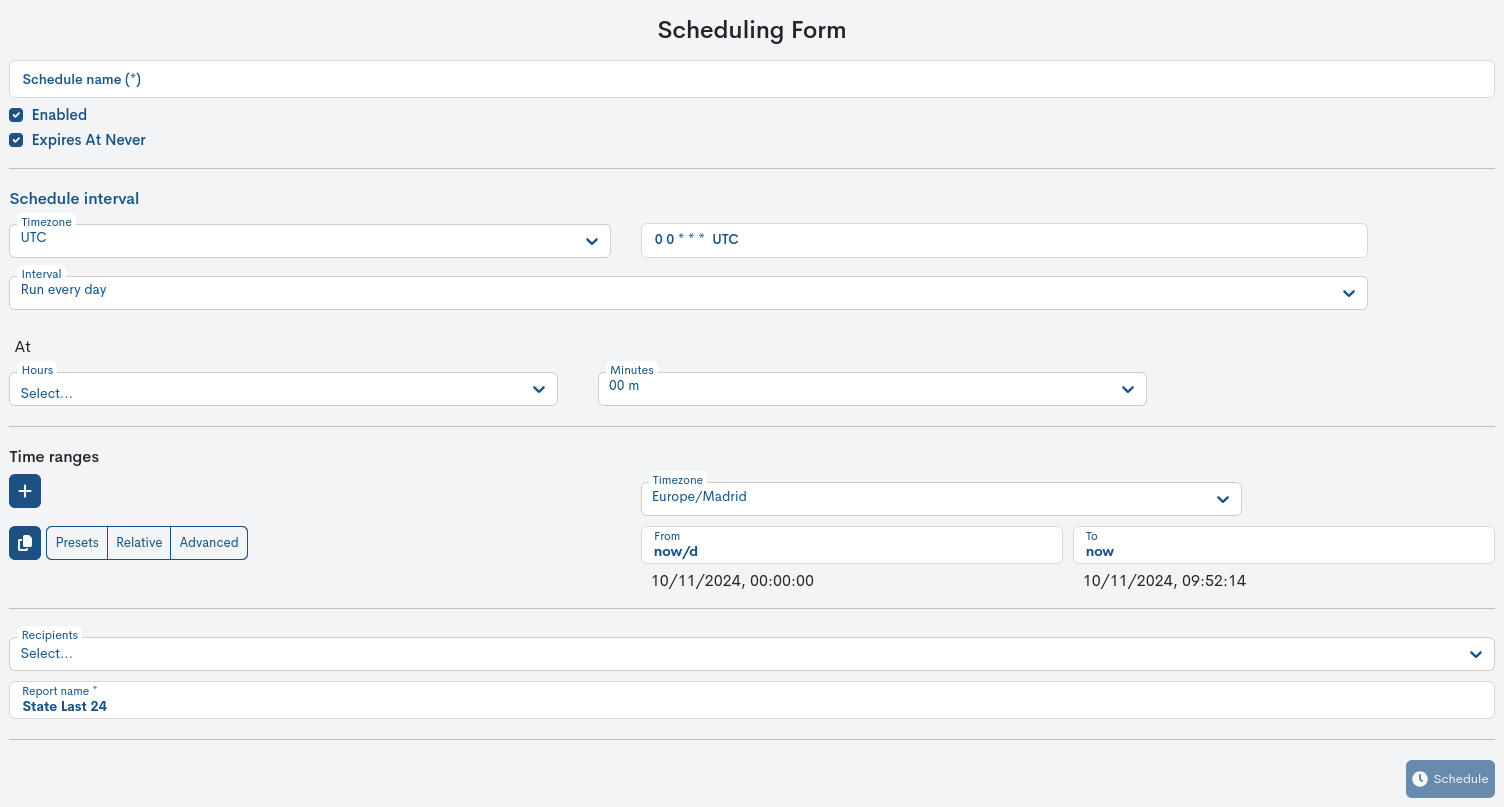
Exporting Device Inventory Reports
WOCU-Monitoring also allows the export of the report in PDF, XLSX and JSON formats. These condense all information on the availability of the monitored assets in a document that can be easily dissemination and simple analysis.
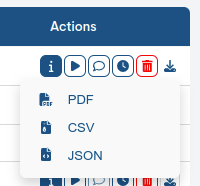
Through the Export selector located in the global report panel, the corresponding files shall be downloaded”
Important
WOCU-Monitoring will return an error message when the report scope exceeds a certain number of devices. The default number is 1,000 devices, but this number may vary depending on the environment and infrastructure being monitored.
Viewing and analyzing Device Inventory Reports
Clicking on the name label (column Name) takes you to the full report.

The report’s information is presented through interactive panels and graphs, designed to facilitate user interpretation.
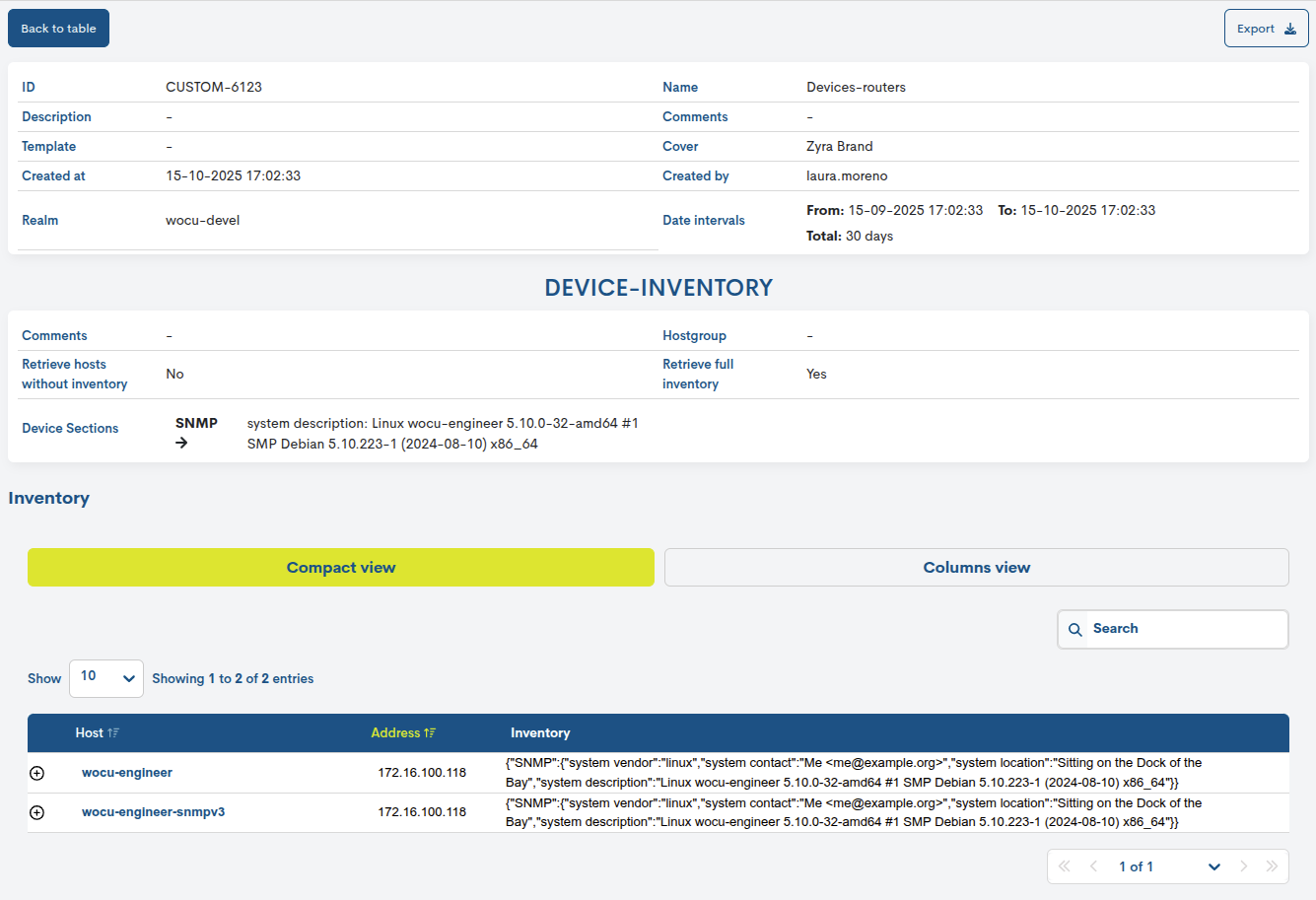
Settings panels
This configuration panel displays the filters and parameters set in the generated report configuration.

These are:
ID: report identifier code.
Description: descriptive text relating to the report.
Template: Templates selected on which the report is based.
Create at: indicates the date and time the report was created.
Realm: indicates the name of the Realm which is the subject of the report.
Name: identification name assigned to the report.
Comments: Free text assigned by the user regarding observations, annotations, or additional clarifications regarding the report.
Cover: Specifies the Covers applied to the report.
Create by: indicates the user who created/owns the report.
Date interval: Indicates the start and end time and date of the availability data collection period.
In multiple time frames, periods will be presented in a tabular format. The total range limit is 31 days.

Comments: Free text assigned by the user regarding observations, annotations, or clarifications
Retrieve hosts without inventory: indicates whether this option has been checked in the report configuration.
Device Sections: reports the filters applied to the report. It displays the sections, keys and values, if they have been applied. The structure that follows is the following:
Section ->
Key ->
Value

Hostgroup: Specifies the device group selected for the report calculation.
Retrieve full inventory: indicates whether this option has been checked in the report configuration.
Inventory Panel
This inventory panel lists a set of Hosts, whose data match the filters applied at the time of launching the report.
There are two display options for this inventory panel:
Compact view
This view condenses the information about the devices that make up the inventory. The following data is provided in a tabular format:

Host:
This field lists the devices that make up the inventory, including the name of each one of them, followed by the realm to which it belongs in square brackets. Clicking on the name (in blue) will display the Detailed view of Hosts and Business Processes.
Address:
Indicates the IP address of the host.
Inventory:
This field shows the data collected in the inventory for a given Host. Clicking on it will display a new view. To hide it, simply click on the blue icon with a minus sign (“-”), located in the upper right corner of the panel.
These new additional data can be displayed in different formats:
Table: displays in a table all the Keys of a Section of a given host.

JSON: displays in JSON format all the keys of a section, from a given host.

Columns view
This column view shows the data in a more detailed way, as it also allows filtering by keys and IP (Address), in contrast to the compact view which offers a more more general view of the data.

The data filtering options are:
Show host address: by default this box is checked, but can be changed by the user to remove the host IP address column, leaving more space for reading data.
Show strict matching hosts: by ticking this box, only the devices that have all the requested data, i.e. that match the selected inventory keys, will be displayed.
For example, after applying the filter in the following image, only will be retrieved only those devices whose inventory has data the key
Operatorotherwise the device will not be retrieved by the system

Important
The different navigation, search and sorting options available on this screen are explained in detail in the section: Common navigation, filtering and sorting options.
Comments
Free text field to add comments, notes, or additional clarifications about the report.